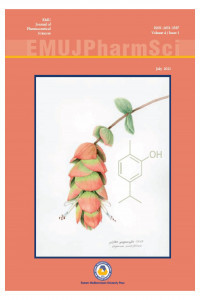Influence of carnauba wax on the release profile of ibuprofen implants
Influence of carnauba wax on the release profile of ibuprofen implants
Carnauba wax, ibuprofen, subcutaneous, implant.,
___
- Alissa R, Sakka S, Oliver R (2009). Influence of Ibuprofen on bone healing around dental implants: a randomized double blind placebo controlled clinical study. Eur J Oral Implant 2(3):185-199.
- British Pharmacopoeia (2012). London, UK: Her Majesty’s Stationery Office: A234.
- Desai KGH, Mallery SR, Schwendeman SP (2008). Effect of formulation parameters on 2-methoxyestradiol release from injectable cylindrical poly (lactide-co-glycolide) implants. Eur J Pharm 70(1): 187-198.
- Garcia JT, Jesus DM, Mungia O, Llabres M, Farina JB (2002). Biodegradable laminar implants for sustained release of recombinant human growth hormone. J Biomaterials 23(4): 4759-4764.
- Gisele R, Da Silva L, Sílvia LF, Rubens CS, Rodrigo J, Armando-da-Silva CJ (2010). Implants as drug delivery devices for the treatment of eye diseases. Brazilian J Pharm Sci 46(3): 585-595.
- Grosser T, Ricciotti E and FitzGerald GA (2017). The Cardiovascular pharmacology of nonsteroidal anti-inflammatory drugs, A Review. British J Pharm, 172(9): 2152- 2158.
- Higuchi T (1963). Mechanism of sustained action medication. Theoretical analysis of rate release of solid drugs dispersed in solid matrices. J. Pharm. Sci 52: 1145-1149.
- Isesele JE, Airemwen CO, Uchendu AP, Asemwota IO, Obarisiagbon AJ and Uhumwangho MU (2021).
- Formulation and in vivo studies of ibuprofen biodegradable implants. Eur J Pharm and Med Res 8(7), 58-65.
- Kanzaria R, Kapadia Y, Lalji B, Desai TR (2012). Implant - controlled release medicated formulation. Int J Pharm and Chem Sci 1(1):59- 66.
- Korsemeyer RW, Gurny R, Doelker EM, Buri P and Peppas NA (1983). Mechanism of solute release from porous hydrophilic polymers, Int J Pharm 15: 25-35.
- Koster R, Anderson M, De Beer EJ (1959). Acetic acid-induced analgesic screening. Federation proceedings 18:412-417. Michael NP, Yogeshvar NK, Michael H and Michael SR. Transdermal patches: history, development and pharmacology. British J Pharm 172(9): 2179- 2190.
- Mohammed MI, Sanjeev E, Shanti S (2012). Design and evaluation of subcutaneous implantable drug delivery system of tramadol using natural biodegradable polymer. Annals Phytomed 2:30-38.
- Negrin, CM, Delgado A, Llabres M, Evora C (2004). Methadone implants for methadone maintenance treatment, In vitro and in vivo animal studies. J Con Release 95: 413-421.
- Oalta R, Grewal Y, Batth S, Singh A (2015). A Survey of analgesic and anti-inflammatory drug prescription for oral implant surgery. Int J Plastic and Aesthetic Res 2: 51-55.
- Onishi HM, Takahashi N and Machinda Y (2005). PLGA implant tablet of ketoprofen: comparison of in vitro and in vivo releases. Biol Pharm Bull 28(10): 2011-2015.
- Onyechi JO and Okafo SE (2016). Evaluation of carnauba wax in sustained release diclofenac sodium tablet formulation J Chem. Pharm. Res 8(3):714-721.
- Purushotham RK, Jaybhaye SI, Ravindra K, Bhandari A, Pratima S (2010). Designing of Diclofenac Sodium Biodegradable Drug Implant for Speedy Fracture Healing. J Chem Pharm Res 3(1) 330-337.
- Rajgor N, Pale M and Bhaskar VH (2011). Implantable Drug Delivery Systems, An Overview Systematic Rev Pharm 2(2): 91-95.
- Rao KP, Jaybhaye SJ, Ravindra K, Anil B, Pratima S (2010). Designing of Diclofenac sodium Biodegradable Drug Implant for Speedy Fracture Healing. J Chem Pharm Res 3(1) :330-337.
- Satish CS (2017). Formulation and Evaluation of a Chitosan-PVA-gellan insulin implant, Int J App Pharm 9(3): 37-41.
- Tian H, Tang Z, Zhuang X, Chen X, Jing X (2012). Biodegradable synthetic polymers: preparation, functionalization and biomedical application. Prog. Poly Sci. 37: 237- 280.
- Wang CK, Wang WY, Meyer RF, Liang Y, Winey KI, Siegel SJ (2010). A raid method for creating drug implants: Translating laboratory-based methods into a scalable manufacturing process. J Biomed Mater Res 5(2): 562-572.
- ISSN: 2651-3587
- Başlangıç: 2018
- Yayıncı: Doğu Akdeniz Üniversitesi
Influence of carnauba wax on the release profile of ibuprofen implants
Collins AİREMWEN, Jude ISESELE, Johnbull OBARİSİAGBON, Emmanuel HALILU, Michael UHUMWANGHO
Pollen morphology of some taxa in the family Lamiaceae (Labiatae) from Turkey
Tea Tree (Melaleuca alternifolia (Maiden & Betche) Cheel) Oil an important medicinal essential oil
Gita PARVİZ, Muberra KOSAR, Fatih DEMİRCİ
Richness of Wild Flowering Plants and Ferns in Northern Cyprus
F. Neriman ÖZHATAY, Ertuğrul ÖZBİL, Sultan ÖĞMEN SEVEN
Moein AMEL, Leyla BEBA POJARANİ, E. Vildan BURGAZ, Ömer TÜRKMEN
